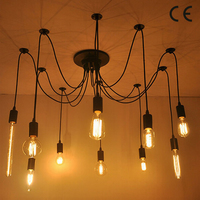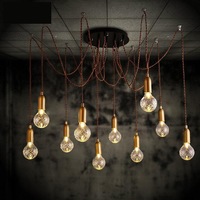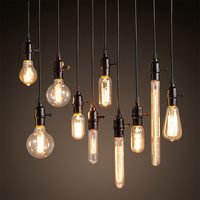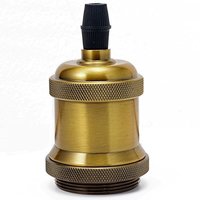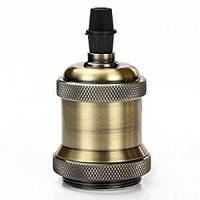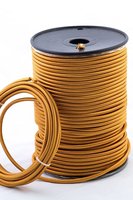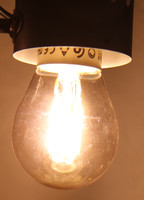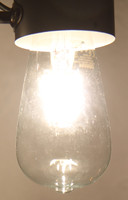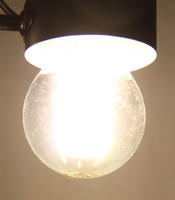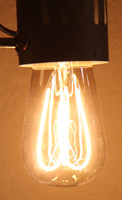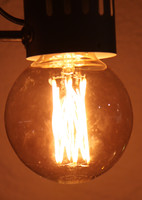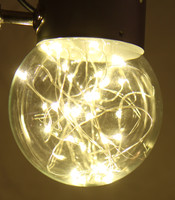Decorative LED light bulbs
In a quest to create a light-arrangement similar to the photo below, I've tried out a number of LED filament light bulbs. They are all European socket E27 220 volt, but with variations on imitations of old style Edison incandescent bulbs, using LED filaments. Some give a normal bright light, while others are warm and dim. But first, some specifications.
An alternative to these LED bulbs might be old fashioned actual Edison incandescent bulbs. Although they were banned for sale in Europe a few years ago, they are still offered from AliExpress, at reasonable prices. It might be worth trying out later. The downside is of course the energy use, at about ten times LEDs, and having to order your light bulbs from China by post.
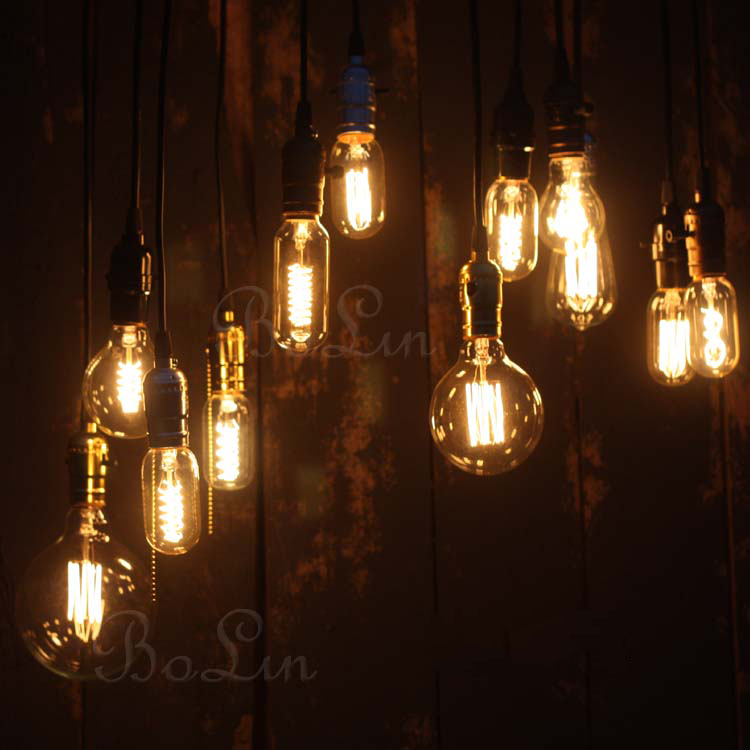
Brightness
The brightness of a light source is expressed in lumen, or luminous flux, where 1 lumen is equivalent to a single candle, while 100 lumen is 100 candles. However, beyond a few candles, it's difficult to have an intuition about what the numbers mean. Here's a rule of thumb for typical light bulb ratings, including those discussed further down:
- 150 lm: very dim and dark; nice for decoration, but impossible to read in this light.
- 250 lm: still dark, OK for dim lamps.
- 400 lm: typical living room light, but would need a handful to light a room.
- 900 lm: excellent reading light, but typically too bright for decoration.
- 1400 lm: excellent working light, bright bathroom light.
- 4000 - 8000 lm: total light in a well lit kitchen or bathroom (depending on size of the room).
Lumen add up linearly from multiple light sources, and a typical kitchen or bathroom would use multiple high-powered bulbs which add up to 4000 - 5000 lumen in a concentrated arrangement. A cosy living-room could have something similar, but typically scattered about over more and lower powered sources.
A dimmer will influence the lumen of a bulb. If it is compatible with a dimmer, it can output less lumens than its normal rating. However, dimming LEDs is not trivial, and will often cause flicker. Even though it might not be visible to the human eye, it will quickly disturb a camera, webcam or mobile phone. The Ikea bulb in this test experienced this issue even without a dimmer involved.

Colour temperature
The colour of a light source is expressed in kelvin, and often more red colors is referred to as warm, while more blue is said to be cold, with standard white light somewhere in the middle. The chart below gives a brief overview, with further examples here.
Again, it's not easy to have any intuition about the numbers, so here's some guidelines based on the bulbs in this article. Also note that different manufactures apply these values differently, so 3000 K might not always give the same colour. In particular, cheaper china-modules will often lower the advertised temperature, to not come off as cheap neon-light products, but will sometimes disappoint when plugged in.
- 1800 K: Very red, like a candle light; OK for decoration, but uncomfortable to read or focus.
- 2000 K: Nice and decorative, but not good for reading.
- 2200 K: Approaching normal living room light.
- 2700 K: Almost normal white light, good for living room.
- 3000 K: Typical normal white reading and working light.
- 5000 K: Typical fluorescent white light, still for household use.
- 7000 K: Blue hospital light.
Different colours from different light sources mix very poorly. One of the lamps will quickly feel out of place: Think for example of a cool bright fluorescent light suddenly being turned on at a cosy cafe; next you'll expect to be thrown out. Or a red lamp in an otherwise bright office-lit room; is somebody growing weed in that corner? Worse than these scenarios yet, is putting cool and warm coloured bulbs next to each other in the same lamp. It simply looks as if somebody didn't stock up on the right bulbs and had to take what was available, or maybe bought the wrong kind from AliExpress. Speaking from experience.
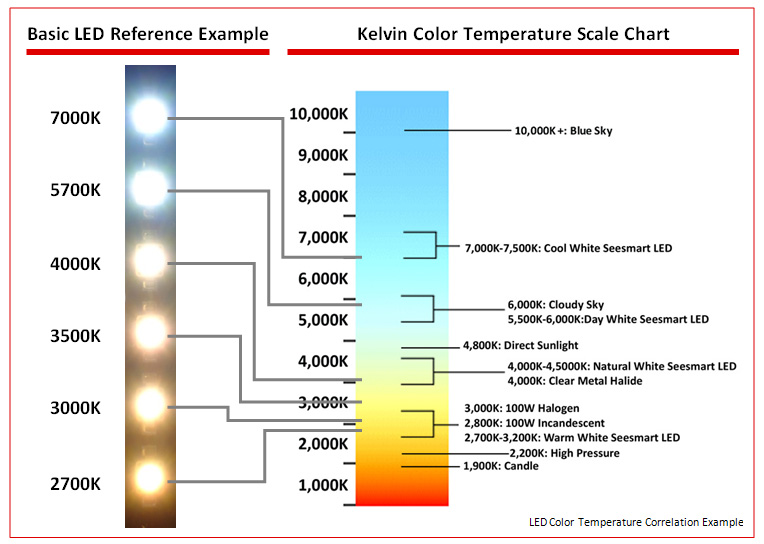
Shapes
There are lots of different types of bulbs, sizes and shapes. Courtesy of mapawatt, here's an overview of different kinds. The A (normal) and G (globe) annotation you sometimes see used on products. The sizes in America are in 1/8 inches, while millimeters is used in Europe. E.g. an A19 is an A shape bulb which is 2.375 inches in diameter (19/8). The A19 size happens to be the standard light bulb size, for example as seen in the GO/ON and Osram 11 W bulbs below. 2.375 inches is 60 mm, which is the diameter of the those bulbs at its widest point, thus the European marking will be A60. Another common size is the G30, a globe of of 25 / 8 inches or 95 mm, which is the shape of the two large bulbs at the end of this test. Finally, the "oblong pear" is common, as ST64 (mm) or ST20 (1/8 inches).
Be ware, sometimes the size annotation is mixed up or combined; like in this offering, which is marked as both as G30 and G95, or this, where it's called G40, but is in fact a small 40 mm or 1.5 inches bulb. Here is a really large G40, at 5 inches or 125 mm, also known as G125.
Different sizes and shapes go well together, as seen in the photos below.
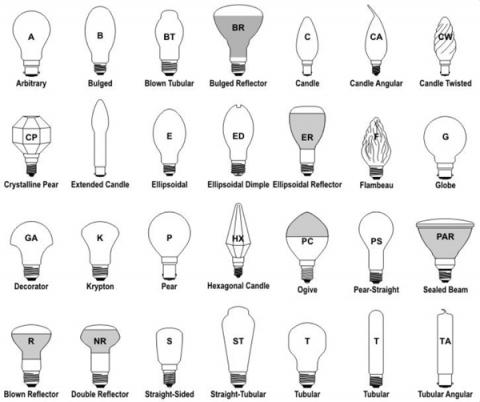
Arrangement, wire and fixtures
When it comes to the arrangement of such a setup, there are many ways of creating an interesting look. Some go for an orderly symmetric shape, which makes it look like a chandelier, while others are intentionally disorganized and scattered at different heights and positions. In between, there's the "plank" instillation below, which uses a dark wooden board as the mounting-point, but still has many different sizes and heights.
To go with the bulbs, the wire and fixtures also become very visible parts. The textilkabel-shop in Germany sells every kind of fabric coated lamp wire imaginable, in colours types, and by the meter. Then there's fixtures, and these classic styled sets look nice, also pictured below.
Ikea Lunnom LED, 400 lm, 4.2W, 2200K |
||
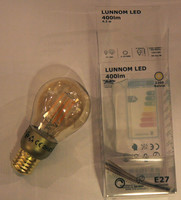
Price: €8.50
Ikea's standard filament LED bulb an A60, but slightly longer than a normal sized light-bulb, however will still fit in most lamps. It gives good light, but too warm and yellow for reading more than a page. The glass is light yellow-tinted. Still, it is also too bright to look at directly, so as decoration it would have to be high in the ceiling to avoid accidental stares. |

|
|
GO ON!, 2x LED bulbs, 470 lm, 4.4W, 2700K |
||
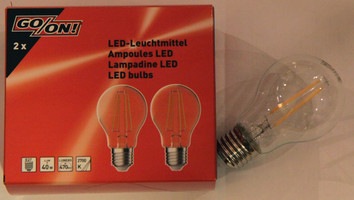
Price: €3 (2-pack for €6)
A normal sized light-bulb for drop-in replacement in most lamps. The light is close to standard white, with a hint of yellow. At 470 lumen, it is bright enough for light reading. However, it is also too bright for decorative use, and its two filaments and standard shape is not too inspiring. |
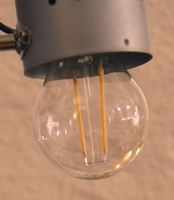
|
|
Osram, pear, 470 lm, 4W, 2700K |
||

Price: €10 An oblong pear shaped large bulb ST64, so potentially decorative. However, the light is close to standard white, and at 470 lumen, it is bright enough for light reading. However, might also be too bright for decorative use. Maybe it could be nice inside a tinted glass enclosure, like a large bottle or vase. |
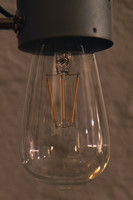
|
|
Osram, bright, 1420 lm, 11W, 2700K |
||
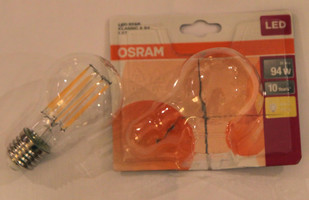
Price: €13
At 1420 lumen, this bulb is extremely bright, and the packing claims the equivalent of a 94 W old style incandescent bulb, while this LED bulb uses only 11 W. It is so bright that looking directly at it for only a second will give black spots, so it has to be used with a lamp screen. It is not rated as compatible with dimmers. It is normal A60 sized, so will fit in any standard E27 socket lamp. |
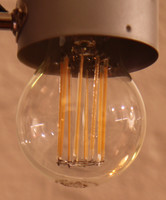
|
|
Micasa Lines & Curves, decorative pear, 140 lm, 4W, 2000K |
||
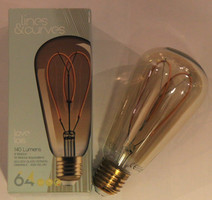
Price: €21
Moving on to the cosy and decorative bulbs, this is an oblong pear shaped large bulb, with a warm dim light. Its two long filaments are shaped in curves, and creates a nice pattern. The smaller "threads" in the center of the bulb in the picture to the right are reflections of the filaments. With its tinted glass, it looks interesting also when turned off. |

|
|
Star Trading, red dark pear, 240 lm, 3.8W, 1800K |
||

Price: €21
At only 1800 kelvin, the Star Trading bulbs are the warmest of this test. In fact, it is so red, it is almost uncomfortable to try to focus on anything in this light. Reading is almost impossible. It should work well as in a cosy setting, as bar light, windows light. And it is dimmable if an even dark setting is required. With its tinted glass and oblong pear shape, it is decorative also when turned off. |
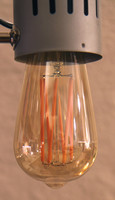
|
|
Star Trading, red dark globe, 240 lm, 3.8W, 1800K |
||
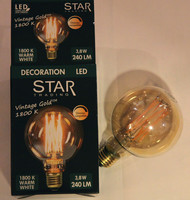
Price: €21
This is bulb has the same technical specs as the pear above, and in fact the only difference is the large globe shape of its outer tinted glass. It is as dark and red, and would work in a similar cosy setting. The price is the same and the service life is the same. |
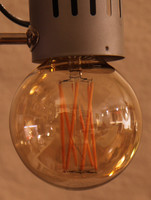
|
|
YWXLight, LED string globe, 200 lm, 2W, 3000K |
||
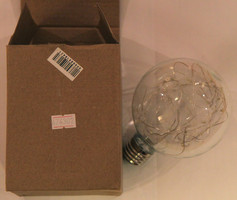
Price: €6
This bulb stands out in that it does not use LED filaments, but instead has packed a string of about 15 LEDs inside a globe bulb, of the same size as the Trading Star above, to create a Christmas-like decoration. It's an innovative "China" LED decoration from DealExtreme, and even comes in a colored version for even more party atmosphere. |
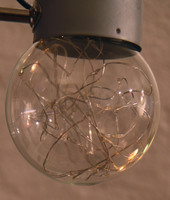
|
|

